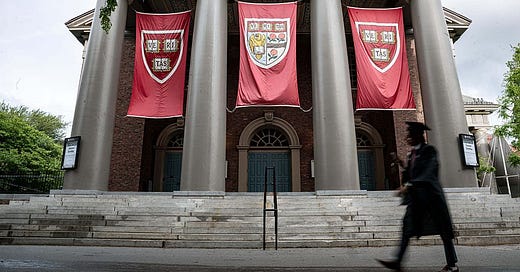Making America Weak Again
Trump’s policies amount to the suicide of a superpower.

This is the latest edition of “Diamond on Democracy,” a series by American Purpose at Persuasion. To receive future installments into your inbox—plus more great pieces by American Purpose and Francis Fukuyama’s blog—simply click on “Email preferences” below and make sure you toggle on the relevant buttons. And while you’re at it, why not subscribe to Persuasion, the Bookstack podcast, and Yascha Mounk’s column!
In my last column, I suggested that the most lasting and catastrophic legacy of Trump’s presidency could well be not the demise of American democracy but the loss of America’s strength and standing in the world—and with it, the liberal international order that has preserved global peace and security and enabled the expansion of freedom and democracy over the last eight decades. Most Americans were born into a world shaped by American vigor, innovation, and leadership. Since World War II, the United States has had the world’s largest economy, the most productive base of scientific research and technological invention, the most powerful military, the most extensive and consequential diplomatic corps, the largest flows of foreign assistance and foreign investment, the most trusted flows of news and information, the densest network of alliances and partnerships, and the biggest impact on global norms, ideas, and culture.
From the end of World War II, the United States led in establishing the global institutions—the United Nations, the World Bank, the IMF, the World Trade Organization, and treaties governing nuclear proliferation and other dangers—that have contained the kind of trade wars, shooting wars, and naked aggression that brought the world to the edge of total calamity.
Donald Trump’s isolationist movement to put “America First” springs from a deep contempt for multilateral institutions and alliances, and indeed for any rule or organization that prevents the United States from doing whatever it wants in the world. But what constrains the United States through transparent rules constrains our adversaries much more, by creating international coalitions against their predatory ambitions. Trump seeks not only to harangue our partners, but to unilaterally dismantle our most cost-effective instruments to maintain American global security and influence. The $50-70 billion the United States has been spending annually on foreign aid is barely 1% of the federal budget, but it saves and extends lives, prevents famine, mitigates violent conflict, strengthens governance, creates new markets for American goods and services, and generates political and moral capital that the United States can draw on to help steer the world away from poverty, chaos, pandemics, dictatorship, and war.
In the previous fiscal year, the United States spent $882 million on the U.S. Agency for Global Media, the umbrella body that oversees all of our global media networks (Voice of America, Radio Free Europe/Radio Liberty, Radio Free Asia, the Office of Cuba Broadcasting, the Middle East Broadcasting Networks, and the Open Technology Fund). That’s 0.013% of the federal budget, or a tenth of a percent of the military budget, or the cost of five or six advanced fighter jets, to provide independent news and information to people deprived of press freedom, and to counter the antidemocratic and anti-American propaganda of China, Russia, Iran, and other dictatorships. You don’t have to be an idealist to recognize why these modest investments are deeply in the American interest. The fastest growing economies and populations in the coming decades will be in emerging market countries, notably in Africa. When we level the information playing field, promote democratic values, and partner with them to develop as open markets and rule-of-law states, we build the kind of world in which America thrives.
Trump’s war on U.S. development assistance—his effort to shut down the U.S. Agency for International Development and defund the National Endowment for Democracy (which helps countries build accountable and representative forms of government)—and his declared intent to shrink the U.S. diplomatic presence in the world, particularly in Africa, are not taking place in a vacuum. These withdrawals from global engagement come at a time when great power rivals—principally China, but in some regions, Russia and Iran—are seeking to reshape the world in their own authoritarian image and to displace the United States from its stabilizing roles and alliances in Asia, Europe, and the Middle East, while also undercutting U.S. influence and access in Africa, Latin America, and the whole Indo-Pacific region. China is bidding for regional domination in Asia and the Pacific, and ultimately for global leadership as well. It has made clear for decades, but increasingly openly and aggressively under Xi Jinping, that China cannot be “great again” unless it “recovers” Taiwan, if necessary by force. Russia is seeking to wipe Ukraine off the map and resurrect not the Soviet Union but the Russian Empire, with the former Soviet Republics as satellite states.
This acceleration of great power competition increasingly has the look and feel of a new Cold War, a global rivalry between two radically different ways of organizing society—through the top-down domination of an authoritarian ruler and state or the bottom-up openness and competition of the economic and political marketplace under a rule of law. While the former demands unfettered power, the latter affirms liberty and constitutionalism to restrain power. Unlike in the first Cold War, there is no coherent ideology that binds or legitimates the new axis of autocracy—China, Russia, Iran, North Korea, Cuba, Venezuela, and some other lesser powers. What matters is not that China is communist, but that it is Leninist. What unites the revanchist powers is not their views on economics but their hostility to freedom and democracy.
Vigorous, sustained, self-confident and far-reaching American engagement in the world, born out of enlightened self-interest, won the last Cold War. It was by no means simply military power and alliances. Foreign aid, as the former USAID Administrator Andrew Natsios has persuasively written, helped win the Cold War. Beginning with the formative post-war secretaries of state George C. Marshall and Dean Acheson, American diplomacy proved crucial in forging the global institutions, norms, and alliances that bolstered freedom and security. Later secretaries of state of both parties, including George Shultz, James Baker, Madeleine Albright, and Condoleezza Rice, have each testified in their memoirs to the power of American diplomacy to advance freedom and secure peace. And countless diplomats—including Michael McFaul, who served a legendary stint as U.S. Ambassador to Russia—have testified to the role U.S. ambassadors and embassy staff play in advancing U.S. security and economic interests, helping us understand foreign countries and leaderships, and building American “soft power” through public and private engagement with diverse sectors of society.
Trump’s dramatic steps and reported plans to downsize and politicize our foreign service, close nearly 30 embassies and consulates, and slash funding for international and multilateral organizations, is staggeringly penny-wise and pound foolish. And it comes at a time when China is doing the reverse. According to Australia’s Lowy Institute, China has now surpassed the United States in having “the most expansive diplomatic network in the world,” with “a larger diplomatic footprint than the United States in Africa (60:56 posts), East Asia (44:27), the Pacific Islands Countries (9:8), and Central Asia (7:6).” On every front, and in virtually every location, China is eagerly occupying the material, political, and ideational spaces that the United States is recklessly vacating. What a formula to “Make America Great Again.”
“The Suicide of a Superpower”
Incredible as it may seem, these massive, cavalier, self-inflicted wounds do not represent the most serious dimension of damage to our national interest. Over the course of the decade that follows Trump’s wreckage, it may be possible to rebuild USAID, our global media infrastructure, our diplomatic corps, and other instruments of our global soft power if we can generate a renewed public appreciation of their importance and a revitalized bipartisan commitment to funding them. That alone will be an immense uphill battle. But we may never recover from the other dimension of Trump’s campaign to make America weak again—his war on science. The scope and depth of the devastation Trump is wreaking on American leadership in science and technology is so massive and sweeping that it is hard to understand without resorting to a preposterous theory, such as that Trump is an agent not of imperial Russia but of Communist China, or that he is simply, literally mad. In truth, Trump is an angry populist whose hatred and resentment for established institutions and elites is so profound that he is willing to cut off America’s nose (and ears and eyes) to spite what he views as its arrogant, “woke” face.
And so we have some of the other shocking turns of Trump’s first 150 days: his punishment of elite liberal universities under the guise of fighting antisemitism; his massive punitive cuts to the research funds of major universities and to the budgets of the National Science Foundation and the National Institutes of Health; and his vow to deny student visas not only to all of Harvard’s international students but possibly to most or all students from countries he doesn’t like or considers a threat, most of all China.
As the United States has lost its lead in so many areas of manufacturing, its economic vitality and global influence have been sustained by its continued leadership in services, including research, design, and higher education. The annual global ranking by Times Higher Education shows seven U.S. universities among the top ten (the other three are British) and thirteen among the top twenty. Why would any effort to “Make America Great Again” attack one of the most striking dimensions of actual, existing American greatness? Yet Trump is eagerly doing so. In a column last month, Fareed Zakaria warned that Trump’s war on Harvard “is wrecking American competitiveness.” Of the roughly $2.6 billion in Harvard’s federal research grants that the Trump Administration has terminated, more than 90%, Zakaria writes, are for research in the life sciences, studying deadly diseases and possible breakthrough cures. Others, writes Nature, are in fields such as astrophysics and quantum computing. These projects, which help sustain America’s global leadership in health and science, “have virtually nothing to do with the ‘woke ideology’ to which Trump objects,” notes Zakaria. Terminating them will not fight antisemitism or other forms of discrimination at Harvard. But “it will almost certainly knock Harvard off” the Nature Index of the top ten academic institutions in the world in terms of research output. On that list, for the year ending last February, Harvard was number one. The other nine were all Chinese universities.
And of course it’s not just Harvard. Trump has also imposed cuts in research funding in the hundreds of millions of dollars on Johns Hopkins University, Columbia, and the University of Pennsylvania. There is probably more individual punishment to come, along with a proposed general cut of more than $25 billion in government funding for science (including an over 50% cut in total funding for the National Science Foundation) in Trump’s “big, beautiful” budget bill, and steep punitive tax increases on university endowments. Zakaria observes acidly: “In business you water your roses and prune your weeds. This seems like the opposite strategy.”
As noted by the Harvard Crimson writer Julien Berman, basic research is fundamental to the technological breakthroughs that have established U.S. corporate leadership in such fields as biomedicine, computing, smartphones, and, indeed, “the internet itself.” Universities do the bulk of the “fundamental exploratory science too risky for private industry,” because the payoffs are too far in the future. Their research investments, his research finds, deliver five times as many patents as the same amount invested by private industry. And the gains to economic growth multiply where universities and innovative industries are in close proximity and interaction—like at Harvard and Stanford. As former MIT President Rafael Reif observes in an important essay in Foreign Affairs, basic scientific research and applied technological innovation proceed in a virtuous cycle that yields enormous “spillover effects for the U.S. economy.” Take away these investments and you squander the seed corn of American global economic leadership, at a time when China is hot on our heels in virtually every field where it is not (as in batteries, electric vehicles, and hypersonics) already ahead.
We are not going to win the technological competition with China through export controls; they are only a very partial and mostly temporary fix. The key to success is to innovate faster and better. As Rafael Reif argues and as my colleagues and I concluded in our 2023 book on the global trade in semiconductors, Silicon Triangle, this will require increasing U.S. spending on research and development, including federal government investments in university-based science and engineering research, and sustained efforts to attract and retain the best international talent. But so far, the policies of the second Trump administration are moving us in exactly the opposite direction.
A study two years ago by the respected Australian Strategic Policy Institute judged that China was ahead in 37 of 44 fields of advanced technology. One field where the United States led was vaccines—at least until a few days ago, when Trump’s Secretary of Health and Human Services (HHS), Robert F. Kennedy, Jr., violated the pledge he made during his Senate confirmation process and fired the entire panel of experts that advises the Centers for Disease Control and Prevention (CDC) on vaccines. This is worse than short-sighted stinginess; it is voodoo health science, which is inflicting a much broader and more devastating purge on HHS, the CDC, and the Food and Drug Administration (FDA). The Chinese Communist Party-State may be cynical, cruel, and predatory, but it takes science seriously, and it is playing to win. If, by contrast, American policy is driven by myth, superstition, and pique, we are bound to become a second-rate power.
To make matters worse—very much worse—the Trump Administration is piling atop its war on scientific research a war on international student visas. “Today,” notes a recent CSIS analysis, “nearly half of graduates in U.S. STEM PhD and master’s programs are international students, a number that has been increasing over the last decade.” In many of the leading U.S. university departments of computer science, engineering, physics, chemistry, biomedicine, and so on, the percentages are much higher. A 2021 study found that in U.S. universities, international students account for 74% of graduate students in electrical engineering, 72% in computer and information sciences, 71% in industrial and manufacturing engineering, 70% in statistics, 67% in economics, and 56% in mathematics. Many of these departments would simply not be able to function without international students.
We not only need international students in general. If we are to remain the international talent magnet that has made America great, we need Chinese students. Max Boot notes: well over a third (about 110,000) of the roughly 277,000 Chinese students in U.S. universities today are pursuing degrees in math, science, and engineering, the wellsprings of economic innovation and technological leadership. Undoubtedly, some of these students are spying for the Chinese military and party-state, part of a decades-long campaign of illicit technology transfer (i.e., theft of American intellectual property, including military secrets) to “make China great again.” But we need to meet this challenge with targeted approaches, and not a blind sledgehammer. As I have recently noted with two veterans of the first Trump administration, the right approach is to “combine a posture of vigilance on research security with reinvestments in the institutions and people on which American innovation and prosperity depend.”
There is also a more immediate economic interest at stake. Many U.S. universities would find themselves in dire financial straits without the tuition and fees that international students pay. In fact, the payments international students make here not only sustain the financial health of U.S. colleges and universities, but they also significantly reduce the U.S. trade deficit, because they are “exports of education services.” Higher education, writes Dany Bahar of the Center for Global Development, is one of our most successful “export” industries, bringing in “over $50 billion in 2023 alone.” Even viewed through the narrow prism of Trump’s obsession with trade deficits, why would we want to damage one of our greatest export industries?
But the benefits to America of foreign talent extend well beyond education—they pay dividends over a lifetime, if we allow them to do so. As Fareed Zakaria observed, China draws mainly on the best talent among its 1.4 billion people, while the United States, to a unique degree, can attract the best and brightest of the entire 8 billion global population. “The results speak for themselves,” writes Zakaria. “Of America’s top 10 companies, five are run by immigrants.” Max Boot cites a 2022 analysis finding that “one-quarter of all billion-dollar U.S. start-ups have a founder who attended a U.S. university as an international student.” In this way, we are squandering the seed corn of American innovation, as Trump’s xenophobia drives the top young talent worldwide to look to graduate study and postgraduate research and teaching opportunities elsewhere—in Europe, Canada, Australia, Japan, Singapore, and not least, China itself.
While we worry (still with good reason) about China stealing our technological secrets, from weapons breakthroughs to advanced semiconductor designs, the bigger story now is that China is investing daringly to dominate in the technologies of the future, including AI, quantum computing, advanced biomedicine and various forms of renewable energy. And while we pull back from scientific investments to protect the health of our population, China is doubling down, increasing central government budgetary support for science and technology by 10% this year. On April 1 (this is not a joke) HHS Secretary Kennedy fired all the top veterinarians at the FDA overseeing the response to the devastating wave of bird flu spreading across the globe—at a moment when many scientists worry about the possibility of its mutating to enable human-to-human transmission. We should not presume that China is similarly burying its head in the sand. I’ve wondered recently how the global balance of power would shift—practically and symbolically—if the world should face a new pandemic virus for which China has developed an effective vaccine and the United States, having yielded to voodoo theories of vaccine danger, had been rendered a helpless supplicant, begging for China’s beneficent mercy. That could come as well if the United States finds itself in anything approaching a military conflict and China—which is now bidding “to establish itself as the preeminent developer, manufacturer, and distributor of drugs worldwide”—simply halts exports to the United States of pharmaceuticals it substantially controls in world trade, such as antibiotics, some cancer drugs, and over-the-counter pain relievers. China would have powerful leverage if it were ready to cause Americans tangible pain and palpable fear, not just the pain to manufacturers of squeezing the supply of rare earth minerals in a trade dispute.
All of this points in an accelerating and alarming direction. We are on the cusp of a massive shift in the global balance of power that would deliver to the United States a defeat far more existential than anything it suffered in Vietnam, Iraq, or Afghanistan. China surpassing the United States as the world’s dominant power—or even vanquishing it militarily in a conflict over Taiwan—would not be another setback in a regional conflict. It would not be a Sputnik moment from which we could recover by gearing ourselves for a new national sprint. It would be the end, not the recovery, of American greatness—what the China expert Rush Doshi calls the “suicide of a superpower”—with horrific consequences for the freedom, prosperity, and health of Americans (and our allies). As Donald Trump retreats from American engagement abroad and rational policy at home, that is the trajectory we are on. And we may be running out of time.
Larry Diamond is a senior fellow at the Hoover Institution and the Center on Democracy, Development, and the Rule of Law, both at Stanford University.
Follow Persuasion on Twitter, LinkedIn, and YouTube to keep up with our latest articles, podcasts, and events, as well as updates from excellent writers across our network.
And, to receive pieces like this in your inbox and support our work, subscribe below:








